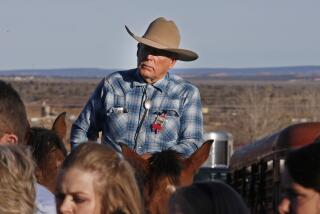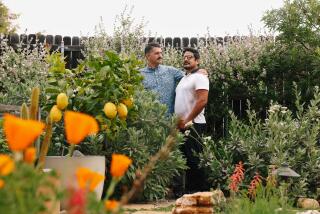Young Rancher Has a Few Blue Ribbons in Stock
It’s called Verdemont Ranch and it turns out more than its share of blue-ribbon specimens: steers, sheep, floral displays--mostly kids.
These days, James Assad and friends are moving up the ladder at the Los Angeles County Fair with their ram, Scotty, and their prize-winning landscaped patio garden, and making even more points with their overall poise, verve, manners. No, they don’t give out medals at the fair for manners. Nor should they, unless you take into consideration Verdemont’s status as a juvenile probation facility for high-risk boys who’ve been in trouble with the law.
At Verdemont, a 240-acre, 60-bed ranch outside San Bernardino, the boys raise animals and/or plants instead of hell. “Crux of the program,” says Allen Driver, longtime agriculture teacher, “is to improve self-image, put the boys where they’ve never been before: in a winning situation.”
Take James, for example. Not yet 17, the Big Bear resident has already scaled the heights of responsibility, aptitude and even love, first with his steer, now with Scotty. James had never seen a steer before he came to Verdemont. Like the rest of the boys who chose to work with livestock, he helped raise Blaze from artifical insemination of the mother through birth to show-quality condition “Hey,” James says, “that’s hard work. But I came to like it.” Especially after his career in the show ring picked up steam.
James won top prizes (not only for his wards but for showmanship, the art of displaying the livestock) at the Great Western, Orange County and San Bernardino fairs, and is undefeated heading into the L.A. contest. Says Linda Frost, Verdemont’s community liaison: “Here’s these boys, hard cases, who’ve never tasted victory in anything, and they’re going up against college students and professionals and they’re winning and it’s transforminbg them.” Inevitably, Blaze was sold, to Arby’s for $4,000, and James turned his attention to his ram. Meanwhile, “I’ve learned how to work with the animals--they get you so frustrated but you can’t get mad--and I guess through them I’ve learned to work with people,” Assad says.
James, too, has been offered several jobs training animals and teaching others to train them. He’s going back to school though--first back to the high school that expelled him, then to college. To study husbandry? “Not really,” James says. “I’d like to major in business and economics.”
‘Sharks Are Beautiful Creatures, Too’
You’re swimming off a Southern California beach and a blue shark glides up to take a look? No problem: Just bop him on the snout and he’ll turn tail. If you’re surfing, though--particularly if you’re surfing in California’s briny “Red Triangle,” a favorite champing ground of the great white--forget it. By the time you’re aware of the shark’s presence, you’re lunch, dad.
So does this make the shark the villain he’s always been portrayed? Hardly, says Chip Matheson, 28, a shark photographer (and fancier) out of San Pedro. “It’s just bad press,” Matheson says. “Sharks are beautiful creatures,” just doing their job and admirably equipped to do it. “Don’t blame the shark,” he says, “blame evolution.”
Matheson, whose new multimedia slide show “Shark!” (music by Chris Cross) is playing weekends at the Cabrillo Marine Museum, concedes that “sharks are predators, not cute and cuddly. But there are 350 species and only 50 can be considered harmful because of their capacity to hurt someone. So can otters and blue whales, but they’re supposed to be the good guys.” Blues, the most common sharks in California, are mainly curious, Matheson says, and while they might think of taking a tentative bite, a shove or a rap upside the head “will most often discourage him. People often ask me, ‘How do you keep from getting bit?’ I just tell them, ‘Keep all parts of your body out of his mouth.”
Great whites, though, are something else. The monsters are slow, so they count on sneaking up on sea lions from below. They see them only as silhouettes, and in the murk of the Red Triangle (the Farralones to Bodega Bay to Ana Nuevo), the surfer just looks like a big, tasty blob.”
Check Matheson’s (free) show, learn sharks’ habits and live longer. “You can predict their behavior,” Matheson says, “at least as much as you can predict the behavior of a driver on the 405 Freeway.”
More to Read
Sign up for Essential California
The most important California stories and recommendations in your inbox every morning.
You may occasionally receive promotional content from the Los Angeles Times.










